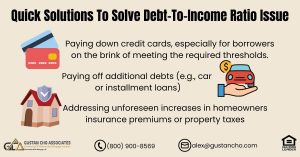This guide covers qualifying and getting approved for a mortgage for self-employed versus W-2 borrowers. Qualifying for a mortgage for self-employed versus W-2 borrowers has become much easier this year. This is due to the emergence of bank statement mortgage loans for self-employed borrowers. Non-QM loans are now back. In the following paragraphs, we will cover the types of borrowers who can benefit from non-QM and alternative mortgage loan programs.
What are non-QM Mortgage Loans?
In this section, we will cover the general non-QM mortgage guidelines. There are no waiting period requirements after bankruptcy or foreclosure. Bank statement mortgage loans for self-employed borrowers. Non-QM lenders will exempt deferred student loans from debt-to-income ratio calculations. Non-QM Lenders will use the higher middle credit score of the borrower. No debt-to-income ratio mortgage loan program. Jumbo mortgages down to 500 credit scores. Jumbo Loans with a 10% down payment and no tax returns/no income verification Just 12 months or 24 months of bank statements for self-employed borrowers
No-Doc Fix-and-Flip Mortgage Loans
No-doc fix and flip rehab loans that can close on the name of an LLC There are no income tax returns required on no-doc fix-and-flip mortgage loans. Borrowers do not have to submit income tax returns. No income documentation is required. 15% down payment on property purchase and 90% financing on a rehab project No income verification is required for investment property loans and portfolio blanket lines of credit on investment properties.
Emergence of Mortgage For Self-Employed Borrowers
Income is the most important factor besides credit for mortgage lenders. Lenders want to know how homeowners will pay their monthly housing payments. A mortgage applicant can have the best credit scores and a substantial down payment, but how can the borrower make the scheduled monthly housing payments for the term of their mortgage?
Mortgage Underwriting Process
Here is what lenders look for when underwriting a borrower:
- Credit and credit scores
- Time of employment at the current job
- Two years of employment history
Gaps in Employment Mortgage Guidelines
Gaps in employment in the past two years allowed for W-2 wage earners. Is the borrower self-employed or W-2?. Self-employed borrowers are considered higher-risk borrowers. Two years of self-employment are required to qualify for a mortgage for self-employed borrowers.
Job Longevity and Employment Gaps Guidelines
Most mortgage borrowers are curious about how long they must work to qualify for a home mortgage loan. Most mortgage lenders will ask the borrowers for two years of W2s and tax returns. What if borrowers have been victims of the financial and credit crisis of 2008 and have been laid off for several years and just got a job?
What if borrowers have re-established and rebuilt themselves and now have a job in a totally different line of work or an entirely different industry?
The good news is that people with bad credit, low self-employment income, and low credit scores can become homeowners again. Non-QM Loans is back. Homebuyers who could not qualify for home loans with traditional loan programs such as FHA and conventional loans can now qualify with short-term bridge non-QM financing.
Can Homebuyers Who Started Brand New Jobs Qualify For Mortgages?
 Lenders normally want to see two years of steady employment by borrowers. Two years of steady employment show employment stability. However, it is not a federal mortgage guideline that borrowers be employed with the same employer for the past two years.
Lenders normally want to see two years of steady employment by borrowers. Two years of steady employment show employment stability. However, it is not a federal mortgage guideline that borrowers be employed with the same employer for the past two years.
Gaps in employment are allowed with W-2 wage earners. If the borrower was unemployed for six or more months, they must be employed with a new job for at least six months to qualify for a mortgage.
If the borrower was unemployed for six months or less, they can qualify for a mortgage with no waiting period, But 30 days of paycheck stubs need to be provided to the mortgage underwriter before a clear to close is issued. Borrowers who have been out of the workforce for extended terms can qualify for a mortgage. This holds as long as they have been employed for six months in their new jobs and do not have to wait for a two-year continuous employment history with the same employer.
Case Scenario: Gaps of Employment on Mortgage For Self-Employed Versus W-2 Borrowers
For homebuyers who have been laid off for less than six months, there is no job longevity requirement on a new job you get. If you have been unemployed for over six months, the lender will want to see a record of six months of continuous employment.
With Mortgage For Self Employed Versus W-2 Borrowers, self-employed borrowers must have two years of continuous employment, unlike W-2 wage earners.
For example, if a mortgage applicant has been laid off for two years and just started a new job on January 1, 2017, they will be eligible for a mortgage loan on July 1, 2017. That is six months from the start date of a new job. If a mortgage applicant just started work after an extended period of unemployment, remember that they do not have to wait two years to qualify for a mortgage loan. It does not matter whether you are employed in the same industry.
Going From 1099 Wage Earner To W-2 Wage Earner
In some cases, a worker goes from a 1099 wage earner (commission base wage earner) to a W-2 wager. Cases like this are common in the real estate industry. The real estate agent may work as a commission 1099 wage earner at a real estate office. Then, transfer to a salary operations office job and become a W-2 wage earner.
Here is how it works. To qualify for a home loan for borrowers who are 1099 wage earners, two years of employment history is mandatory as a 1099 wage earner.
The average of the two years is used to qualify for an income. If the 1099 wage earner goes from the 1099 to the W-2 wage earner, then the income from the new employment offer letter is used. Prior write-offs on tax returns can be exempt from debt-to-income calculations if the borrower can prove that those write-offs will no longer be used due to the new W-2 wage-earner position. 30 days of paycheck stubs are normally required before the underwriter issues a clear to close.
Going From W-2 Wage Earner To 1099 Wage Earner
The following rules apply if the above situation were reversed: a borrower goes from a W-2 wage earner to a 1099 wage earner. The borrower now needs to wait two years from the 1099 wage-earner status start date to qualify for a mortgage loan. This is a major hurdle when qualifying for a mortgage loan. The W-2 wage earner status is no longer valid, and the borrower is treated as a self-employed home buyer. Self-employed homebuyers can now qualify for home loans with 12-month or 24-month bank statement mortgage loan programs. Non-QM Loans may be an option for homebuyers who go from W-2 Wage Earner status to 1099 Wage Earner status.
DTI Issues With Qualifying For Mortgage For Self-Employed Versus W-2 Borrowers
Debt-to-income ratios are one of the biggest hurdles to qualifying for a mortgage for self-employed borrowers. HUD, the parent of FHA, has set very lenient FHA guidelines on DTI. Here are the FHA Guidelines On DTI: Homebuyers who need more information on mortgages for self-employed versus W-2 borrowers can contact us at Gustan Cho Associates at 800-900-8569 or text us for a faster response. Or email us at gcho@gustancho.com. We are available evenings, weekends, and holidays seven days a week.









What about going from Self Employed to W2, I’ve been self employed as a truck driver for 20 years but sold my truck and tool a full time driving job with UPS in June. Will this work.
Hi Garrasimo,
Yes, We can definitely help you. When is the best time to talk?
For questions and concerns you may call us directly at 262-716-8151.